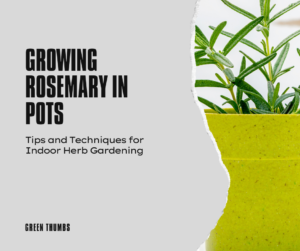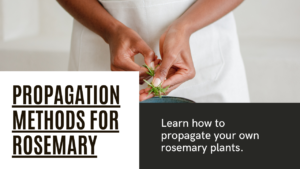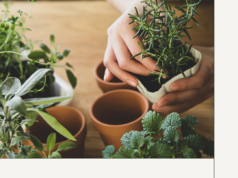
Welcome to our comprehensive guide on growing rosemary plants in pots. Whether you have limited outdoor space, want to have fresh herbs within easy reach, or simply love the aromatic scent of rosemary, this article will provide you with the necessary steps to successfully cultivate rosemary in pots.
With its beautiful foliage and flavorful leaves, rosemary is a versatile herb that can enhance the taste and aroma of numerous culinary dishes. By growing your own rosemary plant in pots, you can enjoy the convenience of having this herb readily available for your cooking needs.
In this guide, we will cover the best pot options, ideal growing conditions, care tips, pruning techniques, and more. Whether you are a seasoned gardener or a beginner in the art of growing herbs, this article will equip you with the knowledge you need to successfully nurture and harvest your own rosemary plants.
Key Takeaways:
- Growing rosemary in pots allows for easy access and saves space.
- You can control the plant’s environment to provide optimum growing conditions.
- Potted rosemary is portable and can be moved indoors during colder months.
- The right pot size, material, and drainage are crucial for healthy plant growth.
- Finding the best location for your rosemary plant is essential for its well-being.
Benefits of Growing Rosemary in Pots
Growing rosemary in pots offers several advantages. Not only does it save space, but it also allows you to control the plant’s environment, making it easier to provide optimum growing conditions.
Potted rosemary is portable, making it convenient to move indoors during colder months or if you have limited outdoor gardening space. This flexibility ensures that your rosemary plant receives adequate sunlight and protection from extreme weather conditions.
“Having rosemary in pots allows you to easily bring the plant indoors when temperatures drop, ensuring year-round access to fresh rosemary for your culinary creations.”
Furthermore, potted rosemary plants are less susceptible to soil-borne diseases and pests, as you can start with clean potting mix and regularly inspect and treat the plants if necessary.
Whether you have a small balcony, limited garden area, or simply prefer the convenience of container gardening, growing rosemary in pots is an excellent choice for both beginners and experienced gardeners.
Choosing the Right Pot for Rosemary
Selecting the right pot is crucial for the health and growth of your rosemary plant. When choosing a pot for your rosemary, it’s important to consider several factors such as size, material, and drainage. Taking these factors into account will ensure that your pot provides sufficient room for root development and proper moisture management, allowing your rosemary plant to thrive.
Size: The size of the pot is an important consideration when selecting the right one for your rosemary plant. A pot that is too small can restrict root growth, leading to stunted development and poor health. On the other hand, a pot that is too large can result in excess moisture retention, increasing the risk of root rot. Aim for a pot that provides enough space for the roots without being overly spacious.
Material: The material of the pot can also impact the growth of your rosemary plant. Opt for pots made from breathable materials such as clay or terracotta. These materials allow for better air circulation and moisture evaporation, preventing waterlogged soil and promoting healthier root systems. Additionally, clay and terracotta pots are generally more aesthetically pleasing and can enhance the overall look of your rosemary plant.
Drainage: Adequate drainage is essential to prevent water accumulation in the pot, as excessive moisture can lead to root rot and other fungal diseases. Look for pots with drainage holes at the bottom to allow excess water to escape. If you come across a pot that doesn’t have drainage holes but you love its design, consider drilling holes at the bottom yourself. Just make sure to place a saucer or tray underneath to catch the drained water.
To help you visualize the factors to consider when choosing the right pot for your rosemary, take a look at the following table:
| Pot Size | Ideal Material | Drainage |
|---|---|---|
| Medium-sized | Clay or terracotta | Drainage holes at the bottom |
| Small-sized | Resin or plastic | Drainage holes at the bottom |
| Large-sized | Wooden or metal | Drainage holes at the bottom |
Remember, choosing the right pot is critical for the overall success of your rosemary plant. By considering factors such as size, material, and drainage, you can provide your rosemary with an optimal environment for growth and ensure a healthy and thriving plant.
Selecting the Right Location for Rosemary
Finding the right spot for your potted rosemary is essential. The location you choose will directly impact the plant’s overall health and growth. Consider the following factors when selecting the ideal spot for your rosemary:
- Sunlight Requirements: Rosemary plants thrive in full sunlight, requiring at least six to eight hours of direct sunlight each day. Place your potted rosemary in an area that receives ample sunlight to ensure proper photosynthesis and growth.
- Temperature: Rosemary is a Mediterranean herb that prefers warm temperatures. It can tolerate some fluctuations, but optimal growth occurs between 65°F and 85°F (18°C to 29°C). Avoid exposing your rosemary plant to extreme cold or heat to prevent stress or damage.
- Humidity: Rosemary plants prefer low to moderate humidity levels. They are well-suited for drier climates, making them an excellent choice for arid regions. However, they can tolerate slightly higher humidity levels if the air is well-ventilated.
Understanding these ideal conditions will help you select the perfect location for your potted rosemary. Whether you decide to keep it indoors or outdoors, ensure that the spot you choose provides the necessary sunlight, temperature, and humidity levels.
| Sunlight | Temperature | Humidity |
|---|---|---|
| Rosemary requires at least six to eight hours of direct sunlight each day. | Optimal growth occurs between 65°F and 85°F (18°C to 29°C). | Rosemary plants prefer low to moderate humidity levels. |
Planting and Transplanting Rosemary

Proper planting techniques and transplanting tips are essential to ensure the successful establishment of your rosemary plant. In this section, we will provide you with step-by-step instructions on preparing the soil, planting techniques, and best practices when transplanting rosemary into larger pots.
Preparing the Soil
Before planting your rosemary, it is important to prepare the soil to provide the optimal growing conditions for your plant. Rosemary thrives in well-draining soil with a pH level between 6.0 and 7.0. Follow these steps to prepare the soil:
- Choose a potting mix specifically formulated for herbs or create your own mixture by combining equal parts of garden soil, perlite or vermiculite, and compost.
- Ensure the soil is loose and free of any debris, such as rocks or roots.
Planting Techniques
Now that you have prepared the soil, it’s time to plant your rosemary. Follow these steps to ensure successful planting:
- Fill the chosen pot with the prepared soil mixture, leaving about an inch of space at the top for watering.
- Gently remove the rosemary plant from its nursery pot, taking care not to damage the roots.
- Make a hole in the soil that is slightly larger than the root ball of the plant.
- Place the rosemary plant into the hole and backfill with soil, ensuring the plant is at the same depth as it was in the nursery pot.
- Press the soil gently around the base of the plant to secure it in place.
Transplanting Tips
Transplanting rosemary into larger pots allows it to grow and thrive. Follow these tips for successful transplanting:
- Choose a pot that is at least 2 inches larger in diameter than the current pot. This will provide ample space for the plant’s roots to expand.
- When transplanting, handle the plant gently and avoid disturbing the roots.
- Ensure the new pot has proper drainage holes to prevent waterlogging.
- Use the same soil mixture described earlier to backfill the new pot.
Following these steps will ensure that your rosemary plant is properly planted or transplanted, setting it up for healthy growth and bountiful harvests.
Watering and Fertilizing Rosemary
Proper watering and fertilizing are essential for the healthy growth and vitality of your potted rosemary plants. This section will guide you on the optimal watering schedule, effective watering techniques, and suitable fertilizing methods to ensure your rosemary thrives.
Watering Schedule
Establishing a consistent watering schedule is crucial to maintain the right moisture levels for your rosemary plants. Overwatering can lead to root rot, while underwatering can cause stress and nutrient deficiencies.
As a general guideline, water your rosemary plant when the top inch of soil feels dry to the touch. Avoid allowing the soil to completely dry out between watering sessions, as this can negatively impact the plant’s health.
Watering Techniques
When watering your potted rosemary, use a gentle and controlled technique to ensure thorough saturation without causing soil compaction. Direct the water around the base of the plant, aiming to moisten the entire root zone.
Allow any excess water to drain out of the pot, ensuring proper drainage. Avoid letting your rosemary sit in standing water, as this can lead to root rot.
Remember that the frequency and amount of water required may vary based on factors such as local climate, pot size, and plant size. It’s important to monitor the moisture levels regularly and adjust your watering accordingly.
Fertilizing Methods
Fertilizing provides essential nutrients that promote healthy growth and enhance the flavor of your rosemary. Choose a balanced, water-soluble fertilizer specifically formulated for herbs or organic alternatives.
Apply the fertilizer according to the package instructions, taking care not to exceed the recommended dosage. Overfertilization can lead to salt build-up and burn the plant’s roots.
It’s recommended to fertilize your potted rosemary plants every 4-6 weeks during the growing season, which typically spans from spring to late summer. Reduce or suspend fertilization during the dormant winter months.
Remember to water your rosemary before applying fertilizer to prevent root burn and ensure proper absorption of nutrients.
| Watering Tips | Fertilizing Tips |
|---|---|
| – Use well-draining pots and soil to prevent waterlogging | – Choose a balanced, water-soluble fertilizer specifically for herbs |
| – Water when the top inch of soil feels dry to the touch | – Follow the package instructions for dosage and frequency |
| – Water thoroughly, ensuring the entire root zone is moistened | – Apply fertilizer during the active growing season |
| – Avoid leaving the pot in standing water to prevent root rot | – Water your rosemary before applying fertilizer |
| – Monitor moisture levels regularly and adjust watering accordingly | – Reduce or suspend fertilization during the dormant season |
Pruning and Harvesting Rosemary
Regular pruning is essential for maintaining a bushy and compact rosemary plant, while harvesting provides you with a fresh supply of aromatic herbs. By employing proper pruning techniques, you can encourage healthy growth and prolonged productivity in your rosemary plant. Additionally, understanding the best timing and methods for harvesting rosemary leaves allows you to enjoy the full flavor and fragrance of this culinary herb.
Pruning Techniques for Rosemary
When it comes to pruning rosemary, there are a few techniques you can utilize to ensure optimal growth. Here are some effective pruning techniques:
- Pinching: Pinch off the top inch or two of the rosemary stems to encourage branching and denser growth. This technique is particularly useful for young plants or when you want to shape the plant.
- Selective Pruning: Identify any dead, damaged, or straggly branches and carefully trim them back to the main stem. This helps maintain the overall health and aesthetics of the rosemary plant.
- Hard Pruning: If your rosemary plant has become overgrown or leggy, consider performing a hard pruning in early spring. Trim back the plant by one-third to half its size, promoting fresh new growth from the base.
Timing for Pruning Rosemary
Timing is crucial when it comes to pruning rosemary. It’s best to prune your rosemary plant in early spring before new growth begins. This ensures that you won’t be removing any potential flower buds, allowing the plant to produce beautiful blooms later in the season. However, light pruning can be done throughout the year to maintain the desired shape and density of the plant.
Harvesting Methods for Rosemary
Harvesting rosemary leaves at the right time maximizes their flavor and aroma. Here are a few methods for harvesting rosemary:
- Leaf-by-leaf: Simply pluck the individual leaves as needed for immediate use. This method is suitable for small-scale harvesting.
- Stem Cutting: Cut a stem of rosemary just above a leaf node or joint. This encourages new growth and allows you to harvest larger quantities.
- Bundle Harvesting: Gather several rosemary branches together and tie them with a string to create a bundle. Hang the bundle upside down in a cool, dry place to dry the leaves naturally for later use.
Remember to never remove more than one-third of the plant’s foliage during harvesting to avoid stressing the rosemary plant.
Pruning and harvesting are essential tasks to ensure the health and productivity of your rosemary plant. By implementing proper pruning techniques and understanding the optimal timing and methods for harvesting, you can enjoy a thriving rosemary plant that provides an abundance of flavorful herbs for your culinary creations.
Common Pests and Diseases
Rosemary plants are generally resilient, but they can still be susceptible to certain pests and diseases. These issues can negatively impact the health and growth of your potted rosemary plant. By being aware of the common pests and diseases that may affect your plant, you can take proactive measures to prevent and treat them, ensuring the continued well-being of your rosemary.
Pests
Here are some common pests that may infest your rosemary plant:
- Aphids: These small, sap-sucking insects can cluster on the leaves, causing yellowing and distortion.
- Spider Mites: Tiny arachnids that are difficult to detect, spider mites can stunt growth and cause yellow speckling on the leaves.
- Mealybugs: These soft-bodied insects produce a white, powdery substance and can weaken your plant by feeding on its sap.
“Prevention is always the best strategy when it comes to pest control. Regularly inspect your rosemary plant for signs of infestation and take immediate action to prevent pests from spreading.”
Diseases
Here are some common diseases that may affect your rosemary plant:
- Powdery Mildew: This fungal disease causes a white, powdery coating to appear on the leaves and stems, leading to yellowing and stunted growth.
- Root Rot: Excessive moisture or poorly-draining soil can lead to root rot, causing the roots to become brown and mushy.
- Bacterial Leaf Spot: Characterized by dark, water-soaked lesions on the leaves, this bacterial disease can weaken the plant and reduce its overall vigor.
“Maintaining good plant hygiene and providing proper growing conditions are essential to prevent diseases from taking hold. Regularly remove any affected plant parts and ensure your rosemary has adequate air circulation to minimize the risk of disease.”
To effectively prevent and treat pests and diseases in your rosemary plant, consider implementing the following practices:
- Regularly inspect your plant for signs of infestation or disease.
- Practice good hygiene by removing any affected plant parts immediately.
- Promote airflow around the plant by avoiding overcrowding and spacing the pots appropriately.
- Use organic pest control methods, such as neem oil or insecticidal soap, for safe and effective pest management.
- Provide proper watering to avoid overwatering, which can lead to disease development.
- Ensure your rosemary plant is receiving adequate sunlight, as healthy plants are better equipped to withstand pests and diseases.
- Consider using companion plants, such as marigolds or lavender, that repel pests naturally.
By being proactive in pest and disease management, you can maintain the health and vitality of your potted rosemary plant, allowing it to thrive and provide you with an abundant supply of aromatic herbs.
Overwintering Rosemary Plants
Overwintering potted rosemary plants is essential for ensuring their survival during the colder months. By providing the right care and protection, you can help your rosemary plants endure the harsh conditions indoors and continue thriving until the next growing season.
To successfully overwinter your rosemary plants, follow these steps:
- Choose the right location: Find a cool, bright area in your home where the rosemary can receive ample sunlight. A south-facing window is ideal.
- Control the temperature: Rosemary plants prefer temperatures between 50-60°F (10-15°C). Avoid placing them near drafts or heat sources.
- Adjust watering: During winter, rosemary plants require less water. Allow the top inch of soil to dry out before watering.
- Monitor humidity: Indoor heating can cause dry air, which may negatively affect your rosemary plant. Increase humidity by placing a humidifier or a tray of water near the plant.
- Protect from pests: Inspect your rosemary plant regularly for any signs of pests. If necessary, treat them with organic pest control methods.
By following these steps, you can successfully overwinter your rosemary plant and ensure its longevity. Remember to resume regular care and watering once the growing season begins again.
Protect your rosemary plants during the winter months to ensure their survival and continued growth.
Propagation Methods for Rosemary

Propagating rosemary is a simple and rewarding way to expand your herb garden. Whether you want to grow more rosemary plants for personal use or share them with friends, there are several propagation methods you can try. This section covers two popular methods: stem cuttings and seeds.
Stem Cuttings
If you have a mature rosemary plant that you would like to propagate, stem cuttings are a reliable method. Here’s how to do it:
- Select a healthy stem from the rosemary plant. Make sure it is at least 4-6 inches long and has no flowers.
- Using clean and sharp pruning shears, make a clean cut just below a leaf node.
- Remove the leaves from the bottom two-thirds of the cutting.
- Dip the cut end of the stem into a rooting hormone powder (optional) to promote root development.
- Fill a small pot with a well-draining potting mix.
- Make a hole in the potting mix and insert the cutting, ensuring that at least one leaf node is buried in the soil.
- Water the cutting thoroughly, and place the pot in a warm and bright location, away from direct sunlight.
- Maintain moist soil conditions by misting the cutting regularly.
- After a few weeks, you should start to see roots forming. Once the roots are well-established, you can transplant the rosemary into a larger pot or a garden bed.
Seeds
If you prefer starting from scratch, propagating rosemary from seeds is a great option. Follow these steps:
- Obtain rosemary seeds from a reputable source.
- Fill a seed tray or pots with a seed-starting mix.
- Moisten the soil before sowing the seeds.
- Sow the seeds on the surface of the soil, and gently press them down.
- Cover the seeds with a thin layer of vermiculite or fine soil.
- Place the tray or pots in a warm and well-lit location.
- Keep the soil consistently moist, but not waterlogged.
- Germination may take 14-21 days. Once the seedlings have grown a few inches tall, you can transplant them into individual pots.
Note: Rosemary seeds can be slow to germinate, so be patient and provide proper care.
By using either the stem cuttings or seed method, you can easily propagate rosemary plants and enjoy a continuous supply of this delightful herb. Experiment with both methods to find the one that works best for you.
“Propagating rosemary is not only a practical way to expand your herb garden, but it also allows you to grow your plants from scratch and witness their journey from tiny cuttings or seeds to mature and productive herbs.”
| Propagation Method | Advantages | Disadvantages |
|---|---|---|
| Stem Cuttings | – Faster process – Guaranteed genetic traits |
– Requires a mature plant as the source – Slightly more involved |
| Seeds | – Starting from scratch – Cost-effective |
– Longer process – Possibility of genetic variation |
FAQ
Q. What are the benefits of growing rosemary in pots?
A. Growing rosemary in pots allows for space-saving cultivation and greater control over the plant’s environment. Potted rosemary is also portable, making it convenient to move indoors during colder months or if you have limited outdoor gardening space.
Q. How do I choose the right pot for rosemary?
A. When selecting a pot for rosemary, consider its size, material, and drainage capabilities. The pot should provide sufficient room for root development and proper moisture management. Choosing the right pot is crucial for the health and growth of your rosemary plant.
Q. What is the ideal location for rosemary?
A. Rosemary thrives in locations with plenty of sunlight, well-drained soil, and moderate humidity. Find a spot that receives at least 6-8 hours of direct sunlight each day. Whether indoors or outdoors, selecting the right location is vital for the overall health and productivity of your rosemary plant.
Q. How do I plant and transplant rosemary?
A. To plant rosemary, prepare the soil by ensuring it is well-draining and has a pH of 6-7. Plant the rosemary seedling or cutting, ensuring it is properly positioned and well-supported. When transplanting, gently remove the plant from its current pot and transfer it to a larger container, being careful not to damage the roots.
Q. How often should I water and fertilize potted rosemary?
A. Water potted rosemary when the top inch of soil is dry. Avoid overwatering as rosemary prefers slightly dry conditions. Fertilize every 4-6 weeks using a balanced fertilizer or organic options such as compost or fish emulsion, following the recommended dosage on the packaging.
Q. How do I prune and harvest rosemary?
A. Prune rosemary regularly to promote bushy growth and prevent legginess. Harvest rosemary leaves as needed by gently removing sprigs from the plant. Pruning and harvesting should be done with sharp, clean shears. Timing and methods can vary, but generally, pruning should be done in early spring, and harvesting can be done throughout the growing season.
Q. What are the common pests and diseases that affect rosemary plants?
A. Common pests that may affect rosemary plants include aphids, spider mites, and root rot. Diseases such as powdery mildew and root rot can also occur. Proper care, including regular inspection, adequate ventilation, and appropriate watering practices, can help prevent and manage these issues.
Q. How do I overwinter my potted rosemary plants?
A. To overwinter potted rosemary, bring the plant indoors before the first frost and place it in a bright location with cooler temperatures, ideally around 55-60°F (13-16°C). Reduce watering and allow the plant to go dormant. Protect the plant from drafts and monitor for pests. Resume normal care in spring.
Q. What are the propagation methods for rosemary?
A. Rosemary can be propagated through stem cuttings or from seeds. Taking stem cuttings in spring or early summer and rooting them in moist soil or water is a common method. Seeds can be collected from mature rosemary plants and sown in well-draining soil, following the recommended planting instructions on the seed packet.
Conclusion
In conclusion, growing rosemary plants in pots offers numerous benefits and is a convenient gardening option. By following the steps outlined in this guide, you can create an optimal environment for your rosemary plant, ensuring healthy growth and a steady supply of aromatic herbs for your culinary delights.
By carefully choosing the right pot and providing the ideal location, you can control the plant’s environment, making it easier to meet its specific needs. Regular watering, appropriate fertilizing, and timely pruning will keep your rosemary plant thriving and productive.
Furthermore, understanding common pests and diseases that may affect your rosemary plant is crucial to taking preventive measures and ensuring its well-being. Lastly, learning how to propagate rosemary will allow you to expand your herb garden, adding versatility and abundance to your culinary creations.
By implementing the knowledge gained from this guide, you can enjoy the flavorful and aromatic benefits of homegrown rosemary, elevating your cooking experiences to new heights.
















